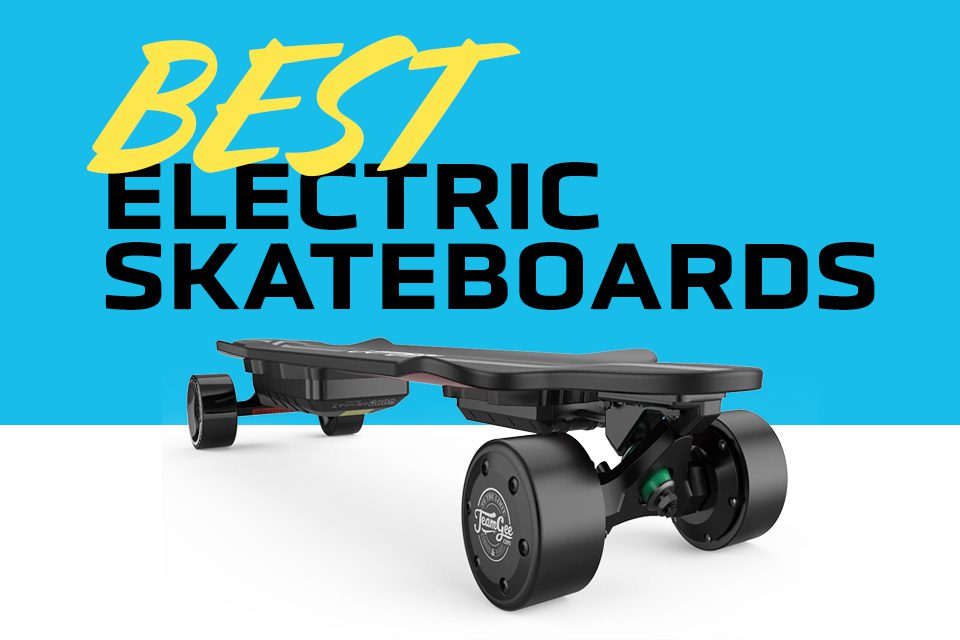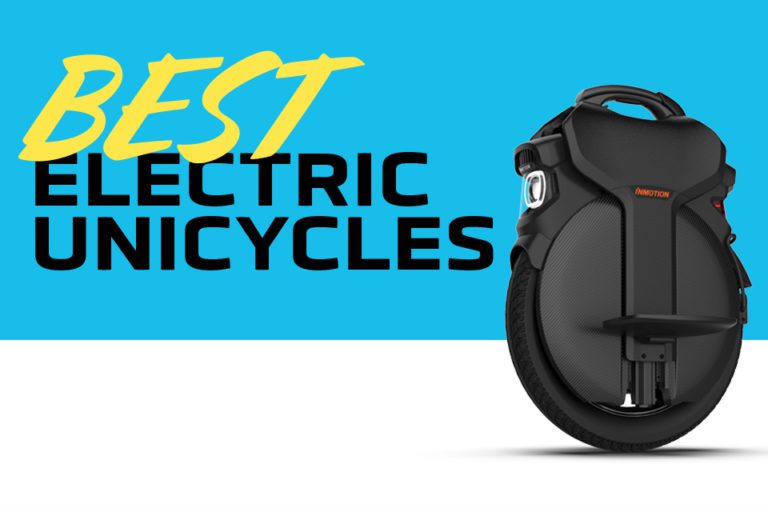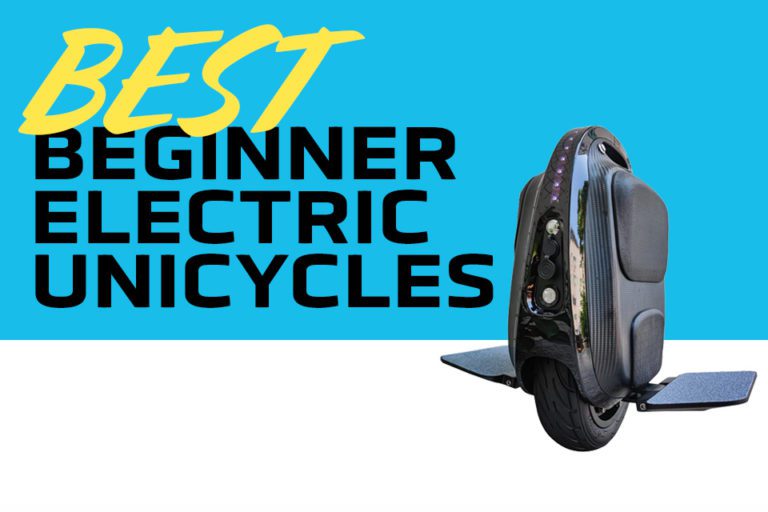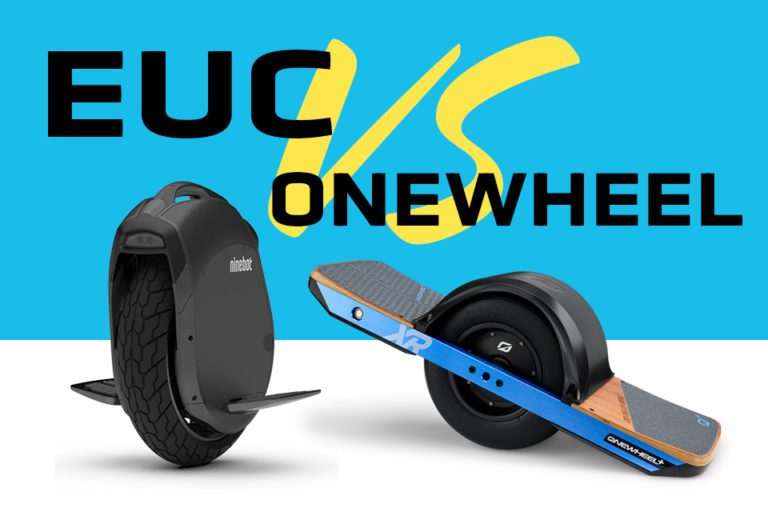Best Electric Skateboards of 2023
The world is changing every single day, and we’re seeing new, innovative methods of transportation.
For commuting short to medium-range distances, electric vehicles, such as bicycles and unicycles, are actually a fairly popular way to get around in big cities (where most of the pollution problems persist).
But there’s another way to get from A to B, and still have some juice to get back, or stop for coffee on the way home.
It’s electric skateboarding. It’s nothing new, but the way that it’s being designed is what’s new about it.
We’ve seen electric skateboard designs around for well over a decade, but just like when outdoor solar lights came out, they were very lackluster.
Technology improves, patents come to light, and new ways of performing old ideas revolutionize things like transportation.
We’ve reviewed the five best electric skateboards based on their battery life, overall design, and ease of use (along with a few other characteristics) so that you can make an informed decision when you decide to pick one up.
Commuting is a part of life, but with electric skateboards, it can be an enjoyable experience every single time.
Best Electric Skateboard – Reviews And Recommendations For 2023
Swagtron Swagskate NG3 Electric Skateboard
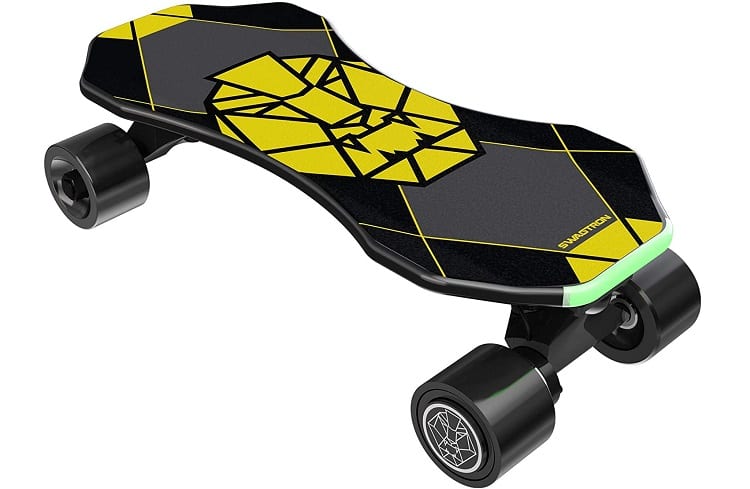
Featured Specs
- Dimensions: 19.6” x 8.9” x 5.3”
- Battery Capacity: 2Ah
- Weight: 7.7 lbs
- Connectivity: N/A
Everything’s better when you can get it at a discount. This electric skateboard is good for both children to use and get used to it, and beginners. As a result, this hybrid model doesn’t have the highest price tag out there. You can get it for relatively cheap, even during their normal price that they host all year long.
I wouldn’t put this in with the ranks of electric off road skateboards, but on the pavement, it does some justice. Thick wheels give you excellent rolling capabilities while protecting the actual skateboard from damage and dents from the pavement, which is always good. You want this to last for as long as humanly possible.
Built in with those great wheels is a shock absorption system. This is designed to make the ride smoother for kids and for beginners, so that you aren’t feeling the roughness of the pavement reverberate through the board and nito your feet. That sort of thing throws off your balance and can discourage new riders, so it’s good that Swagtron had the foresight to address this.
Now, it sounds all good on paper, but while the price tag is low, so is the maximum user capacity. If you’re a hair over 150 lbs, then this board isn’t designed for you. Now the price makes sense: smaller board, less materials, and a lighter grade of said materials because it can’t support a higher weight. Slender young adults might be able to get away with using this if they’re just starting out, but your primary market for these boards are definitely children.
If you’re around the 145 mark, you can feel the tension in the board, suggesting that over 150 it might actually break. Some teens might be able to get away with using this, though. This could be a great commuter vehicle for teens working a summer job or something of the sort.
It is important to note that if you end up buying this for your teen, you’re aware of safety. This board comes with built-in LED indicator lights. While they’re not the brightest things in the world on this little board, they appear brighter to drivers, and shine just a little bit brighter at night. If your kid is coming home as the sun’s going down, this will help keep them safe.
Swagtron capped this out at 9.3 MPH, which is fast enough to actually make your kids want to use it, but not so fast that it’s wildly dangerous. For commuting, it has just enough speed to be used on the sidewalk, but not enough speed that you have to stick to the bicycle lanes. It’s a good middle ground.
One of the main reasons that Swagtron is on our list, as this is about commuting, is that a lot of people in California are able to use them despite the regulations and laws there. They’re very strict on what is classified as a road vehicle even if it’s an electric scooter or unicycle, but Swagtron’s specifications come in just under the wire. If you can properly fit on the board, you’ll be able to zip around with no worries about Johnny Law on your tail.
Teamgee H8 Electric Skateboard
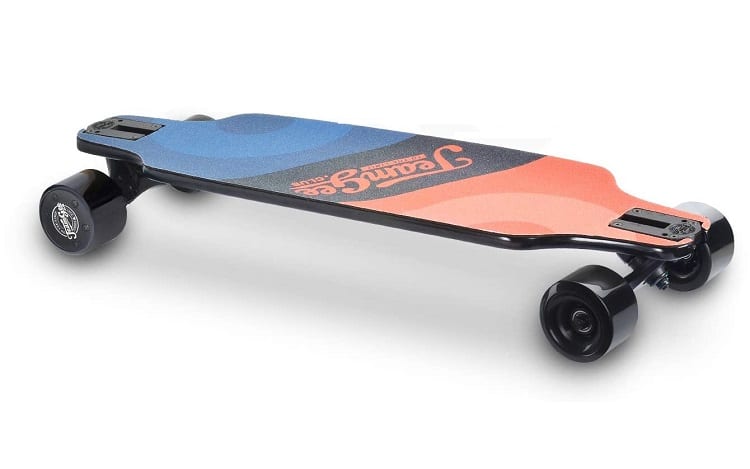
Featured Specs
- Dimensions: 30” x 8” x 0.4”
- Battery Capacity: 3.5Ah
- Weight: 11.6 lbs
- Connectivity: N/A
Temagee might just produce one of the very best electric skateboards out there, regardless of your favorite presets or specifics. That’s because they use a wing tip board design instead of the standard longboard or shortboard, and honestly, it feels great when you’re gliding on it.
Out of the top electric skateboards, Teamgee excels beyond the rest because they simply put everything into every little detail. You might have already heard this elsewhere, and it’s entirely true: they make the thinnest electric skateboard on the market. Go ahead; try to find a thinner deck that can still actually hold user weight and flex when it needs to. It’s a half-inch thick board, which is impressive to say the least.
Your battery is housed inside the deck, protruding from the bottom as little as possible. This not only makes it appear like you’re just using a regular longboard with no motor to it, but gives you greater distance off the ground so you don’t scrape the lithium-ion off a curb and destroy your board in an instant.
In total, you can push this up to 15 MPH, giving you the speed to just zoom through everything in your way when you don’t want to manually push off. The remote control in your pocket allows you to caboose low, medium, or high, and gives a battery display. In the event that you bring your charger with you, this lets you know when you have to stop and either find a cafe, or think about heading home and hope the battery doesn’t die between now and then.
Just as a heads up, your peak speed of 15 MPH does have a limitation to it. This board is thin, the motor is small to account for that, so you can’t really expect any formidable performance after about 15° on a hill. Anything above that is just murder on the board, and you’ll have to push off so that you don’t damage the motor going up.
Crafted out of 10-ply Canadian maple wood and designed with multicolored aesthetics, the board comes durably built and beautifully designed right out of the box. You don’t have the option of another board design here, so you’ll have to get used to what you get. At the moment, Teamgee doesn’t offer another board design because their focus has been on the mechanics of it.
One thing that I’m personally upset to see is the warranty. We know they’re a good board company, but a single one-year warranty on the entire board feels a bit hollow. It leaves you wanting more. This isn’t exactly a kid’s toy, but the warranty sure suggests it.
I will say this, their customer service is pretty fantastic regardless of your warranty’s standing. You can always email them and get a rapid reply with a friendly solution, which is a bonus. The user weight caps off at 160 lbs here, so while this board is built for leaner riders, it’ll take you from A to B without missing a beat in between.
RazorX Cruiser Electric Skateboard
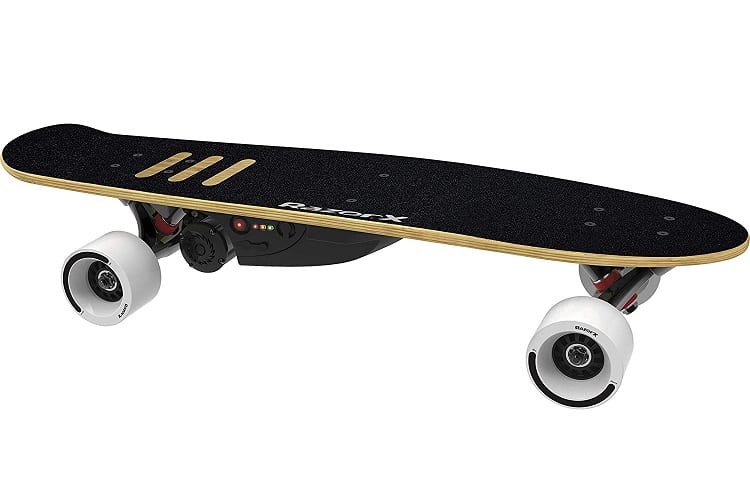
Featured Specs
- Dimensions: 29.7” x 10.6” x 5.7”
- Battery Capacity: 40 mins (no Ah specificity included)
- Weight: 12.8 lbs
- Connectivity: 2.6GHz wireless remote
Razor is still in the game. You know them from the scooters they made when you were a kid, but now it’s time to take a look at what they can do with skateboards. This electric skateboard comes with a decent 125 watt motor, which can grant you pretty good speeds up to about 10 MPH.
10 MPH is the perfect cruising speed for commuting. However, the battery pack technically doesn’t allow this to last for the full hour, so you can’t achieve that full 10 miles from your starting point to your destination. This can still be used manually after the fact, so if you can get to your destination and pop this on the charger, you should be good to go.
Razor really answers the question of “how much are electric skateboards” by showing how you can save money even if you cut down on the end quality that you receive. The board is durable, the battery is high quality, it’s just not the fastest board on the planet. Nothing wrong with that.
If you’re looking at this as a commuting vehicle, you won’t have to even spend half of your FT paycheck to pick it up, which is what makes this such a popular choice. Inner-city travel is basically reduced to a simple task with Razor. Even when the lithium-ion battery pack begins to wane, you’ll still get about five-and-a-half hours instead of the full six hours and fifteen minutes of standard battery use.
Razor designed this so that when it comes to a full stop after a dead battery, it doesn’t screw you over. It comes to a full stop; not a gradual drop-off in speed while the battery is still sitting at a 50% charge. Nothing is more aggravating than that.
The board’s built tough as nails, though, sustaining up to 220 lbs of user capacity, as well as flexing properly with the movements of your board. Most electric skateboards lack mobility, and that’s because when they don’t hit a certain speed threshold, mobility isn’t the biggest issue. You can twist your footing on the RazorX Cruiser like it’s nothing, and sway your angle, which means less manual movements when you need to reposition or lean to one side of the road.
The crappy thing here is that because Razor is typically a brand that sells to children, they can’t make their warranties super long, otherwise you’d have a bunch of kids trying to get warranty redemptions when they used this thing far more than it’s intended to be used. We get the short end of the stick though, because the warranty only lasts for six months for the electrical parts only.
Yes, it could be better, but thankfully Razor has a good set of customer service reps that can walk you through problem solving even if your warranty is expired. They can recommend parts and battery replacements if that’s what you end up needing, all while helping you to save on MSRP costs.
Hover-1 Switch 2-in-1 Electric Skateboard + Scooter
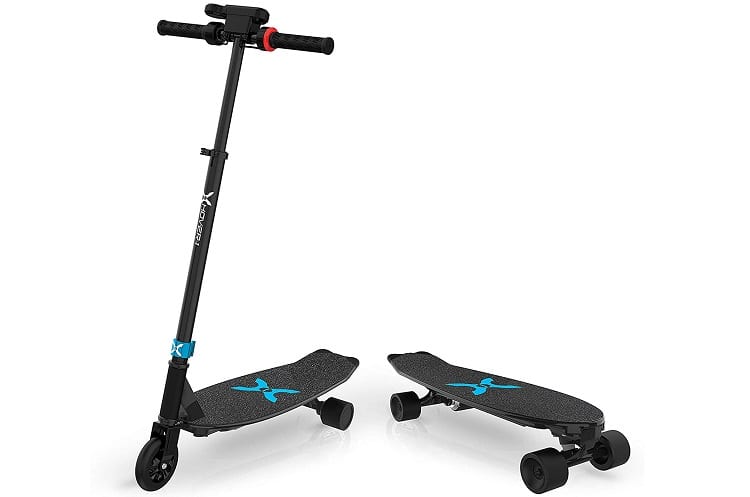
Featured Specs
- Dimensions: 33” x 16” x 39”
- Battery Capacity: 2Ah
- Weight: 36 lbs
- Connectivity: 2.4GHz wireless remote
Skateboard? What about a hybrid beast that can be a skateboard or a scooter? Sometimes, you just don’t have the balance in the early morning to really warrant riding a skateboard to and from work. It’s just not what the morning is demanding from you. That’s okay, because Hover-1 has the solution for you.
In terms of affordable electric skateboards, this sits right at the perfect price point. This is designed for kids, but teens should be able to get some use out of it for summer jobs as well. If they’re too young (or too irresponsible) to drive a car, this is a great alternative. Ideally, you’re a parent or guardian looking to get this for them right now.
You should know that it’s IPX4 waterproof resistant, which isn’t great, but it’s enough to help repel light rain for a short amount of time. They won’t be able to ruin it just because they don’t immediately get into cover once it starts raining outside.
The maximum weight here sits at 132 lbs, and while you can hit that number, you always want to try and aim for at least 5% under just to reduce the load capacity. It’s not a crazy request, though. Just because a weight limit exists doesn’t take away from the fact that more stress on a vehicle will cause problems to occur faster.
If this is for someone who’s either starting a summer job or just as a present, you’ll be happy to know that it caps out at 7 MPH. Enough that there’s some speed and enough fun, but also not enough that it’s going to be a huge safety concern. Anything over this is when you start getting into some danger with the speed.
Detach the handle and turn it into a remote-controlled electric skateboard. All you have to do is put the small remote in your hand or in your pocket, and press it to get the skateboard to move on its own while you guide it with your footing and placement.
This is a lithium-ion battery, so recharging is just like you would do with your cell phone or laptop. The thing is, this doesn’t have the highest capacity, which is bad for longevity, but good for quicker charges. If this is being used by a child for leisure, then you’re going to be able to charge it up pretty fast and get them back on it.
So where are the major downsides? For one, there’s absolutely no warranty to be found anywhere. Even when you get it in the mail, there’s no warranty information. You would have to contact Hover-1 directly to get the information from them and see if they could even replace it.
The quality is good enough, and the weight is decent, so your little ones won’t have a problem lifting it up on their own if they fall and it gets stuck. A solid choice for either a teenage commute, or a child’s toy to use outside.
Surfwheel SU Self-Balancing Electric Skateboard
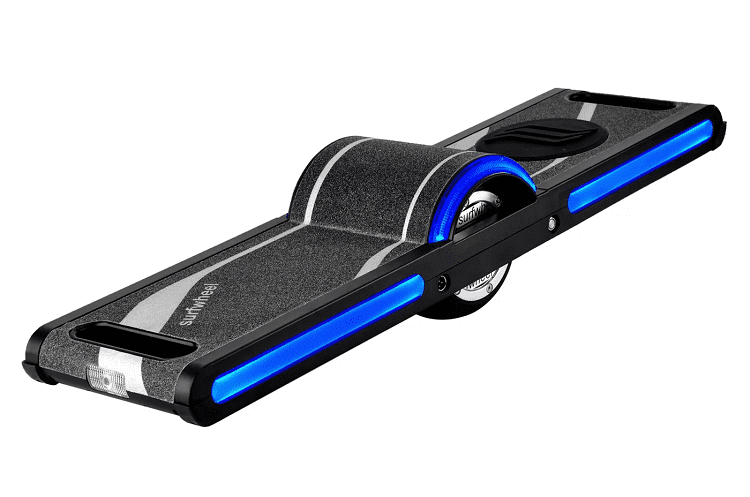
Featured Specs
- Dimensions: 26” x 7” x 5.3”
- Battery Capacity: Up to 1 hour of charge
- Weight: 19 lbs
- Connectivity: App-enabled
Good electric skateboards are hard to come by. You have a few dozen Chinese knock-offs with questionable batteries for every one quality board that’s out there. Well, Surfwheel stands out among the rest for a good amount of reasons.
Right away, you’re going to notice the singular wheel in the middle. How could you not? This doesn’t operate like normal skateboards, which is exactly what we love about it. All the power you get from this skateboard comes from a spot in the middle of the board.
While it sounds like a futuristic design, it actually allows for better weight distribution. The singular roller-like wheel is wide enough to support user weight, as well as brake fairly easily.
Use the app to control your electric skateboard right away, and from there, you’ll get a nice added aesthetic boost of LED lighting that shines on the ground. It isn’t super bright, but if it’s being used in the street during the late afternoon, no cars are going to come down the road and not see you using it. This also helps with late-night commuting away from work.
One reason that this is such a powerful commuting vehicle is that it only goes up to 12 MPH. That sounds like a negative thing, but it makes it easy to control on tight corners without feeling your footing slip away or being thrown from the board. It’s good for commuting in the city, and the lower MPH doesn’t drain a lot of the battery like high discharge rates often do.
However, the weight cap is a little lackluster, only holding up to 180 pounds. While this can be viewed as a leisurely vehicle or toy to some, this has the potential to help you get from A to B all day for work, so the weight limit can be a problem. Even if you’re slender, you have your clothes and most likely a backpack to worry about as well, which can be a cause for concern.
The warranty is very standard. One year against manufacturer defects, but nothing against damages. With that one wheel in the middle, replacements are expensive because they’re not widely accessible like standard skateboard wheels are. It’s a good unit, it’s not very expensive, it just comes with some picadillos that other electric skateboards simply don’t.
Electric Skateboard Buying Guide And FAQ
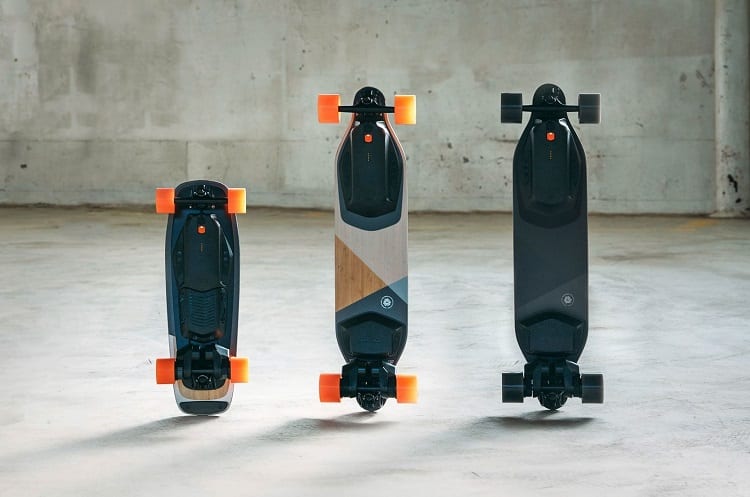
How do Electric Skateboards Work?
You saw the top 5 electric skateboards, but now it’s time to learn about how they work, inside and out.
This is a basic rundown on how each component works together and why your electric skateboard actually moves.
Electric skateboards are simple, standard skateboards—four wheels, two axles, and the bendable board itself.
The only difference is the presence of a battery-operated motor.
This generally connects to the back two wheels, since most riders stand towards the back of their boards and shift their weight here.
This allows for better movement and weight distribution while riding.
You may have one or two motors (if you see dual-motor units, this is what it means) to operate the two back wheels.
Instead of having your standard axle and mount for the wheels, this is replaced by a motor where the axle may either slide through, or be replaced by a different axle altogether.
The axle is belt-driven, meaning a rubber belt forces the axle to turn with the help of plastic gears.
Energy from the battery is transferred to the motor, and the kinetic energy that the motor produces forces the wheels to move forward.
Electric skateboards work better when there is less rider weight. Electric energy converts to kinetic which makes the wheels turn, giving you acceleration on your board.
How Fast Are Electric Skateboards?
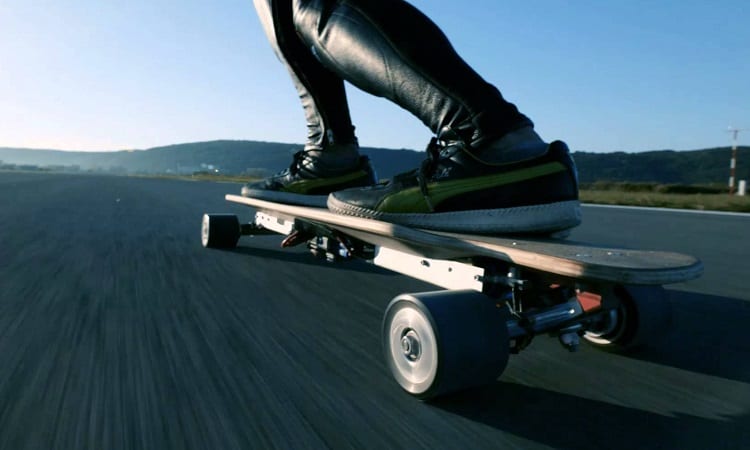
Electric skateboards can go up to 68 MPH. I say this as a very generalized statement, because as of right now, there’s a single board that can do that (and it ain’t cheap).
However, your standard boards are going to go between 12 MPH and maybe up to 26 MPH.
This is just an average if you search for dozens of the leading electric skateboards out there and compare notes.
These electric skateboards reviews don’t showcase the fastest boards out there, because our goal is to find you something you can safely commute with that isn’t going to get you on the wrong side of the law.
Extremely fast skateboards are awesome, but they’re fairly rare and for good reason: they’re illegal in a lot of places in the United States.
We talk about the legality of electric skateboards more in depth later on in the guide.
Basically, the majority of states seem okay with electric vehicles in general, but some states are very strict.
Those looser states still have road laws that need to be enforced, and these high-powered electric skateboards have very little control compared to most cars on the road, so it becomes a safety concern.
While I’m all for electric skateboard use, I can see why they’d draw that conclusion.
When you make your own DIY electric skateboard, you can set the speed based on the quality of parts you purchase.
Higher discharge batteries, stronger motors with more wattage, you get the gist.
It should be noted that if you buy an electric skateboard that can send you to speeds over about 30-35 MPH, the price increases by an extreme.
Do Electric Skateboards Have Brakes?
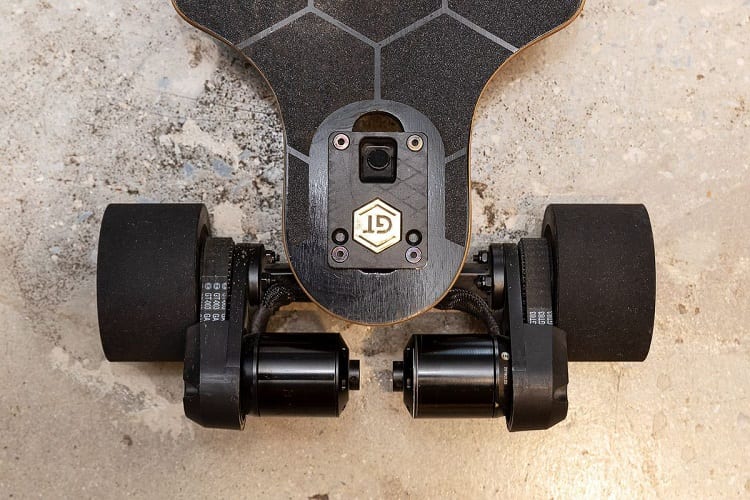
Anything that includes a motor with no breaks is a bad idea. Even RC cars have brakes on them.
Yes, electric skateboards do have brakes installed on them.
If you’re already used to riding a manually-powered skateboard, you might instinctually press your foot to the ground to stop your board.
This will stop it. There’s nothing wrong with doing this when you’re using it on private property.
However, it’s like driving with both feet—doable, but dangerous. You run the risk of falling off your board when you do this because of the momentum shift, and your board could just keep going.
In fact, if you’re holding your phone or remote control and you don’t stop the acceleration, it will keep going.
It’s not a good solution to stop short when you’re using it to commute.
If you notice that someone is trying to cross in the crosswalk while you’re in the bicycle lane, and you go to stop like this, the board could keep going, lose control, and hit them at 19+ MPH.
It’s not a good scenario to find yourself in.
One of the most important things regarding operating an electric skateboard is proper braking.
You’re going to have this knee-jerk reaction to put your foot on the asphalt to slow the acceleration, but it’s not the right way to do it.
You could just knock yourself off the board. Apart from personal and public safety, you’re also going to damage the motors on your wheels.
They’re meant to move, and when you put that much resistance against them, it can wear down the motor.
This would require constant braking with your feet to do real damage, but you don’t want to inflict even small amounts of damage on your board if you can avoid it.
We did this electric skateboards review guide to show you the best of the best, and to tell you what’s possible and what’s out there.
Just be sure you’re using everything intelligently and appropriately for others’ public safety.
Get in the habit of using the brake system instead of your foot before you start commuting with this.
Do You Need a Helmet to Ride an Electric Skateboard?
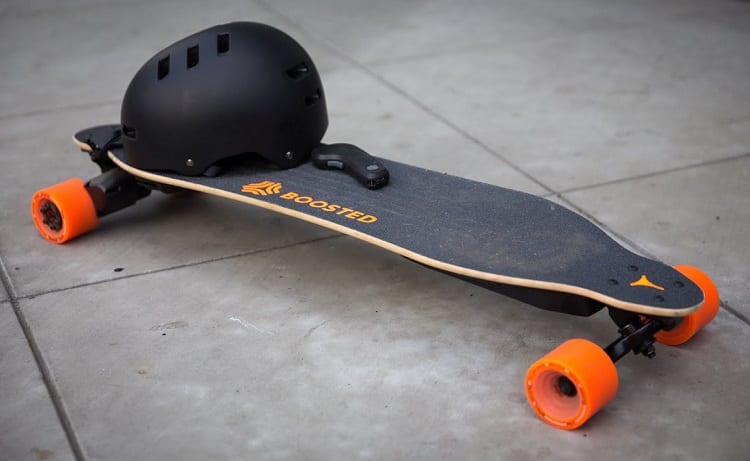
Well, I would recommend it. Even if you only have a board that can go 12 MPH, I want to ask you this: can you get hurt by falling when you run?
People run about 7 MPH on average, and if they fall forward, they’re going to get hurt, even risk hitting their head on the sidewalk.
If you’re not wearing a helmet, you’re being foolish and setting yourself up to be hurt.
We all like to think “Oh, I’ve got this” and that we won’t fall or injure ourselves, but you really never know.
That’s just the common sense side of things, but as we’re going to learn, the law isn’t in favor of electric skateboards at the moment.
You have one of the best electric skateboards. You stay in the bicycle lane, you don’t intrude on pedestrian’s right-of-way, you’re an all-around responsible operator.
However, in some places (looking at you, California), you may need to wear one by law.
There’s this instance that really sets the precedence for electric skateboard use in places like this with strict laws.
According to Greg Hill & Associates, a Los Angeles lawyer’s office, the vehicle code in this area states that as long as you’re wearing a helmet (and obeying the speed limits in vehicle code 21292 of California state law), that you can operate one of these.
The helmet is the key. You should wear one for your safety, but also so you can actually use your electric vehicle without any issues.
It would be pretty ridiculous to spend a few hundred on a skateboard, then twice that amount in traffic court because you used it.
Can Electric Skateboard Batteries Overheat?
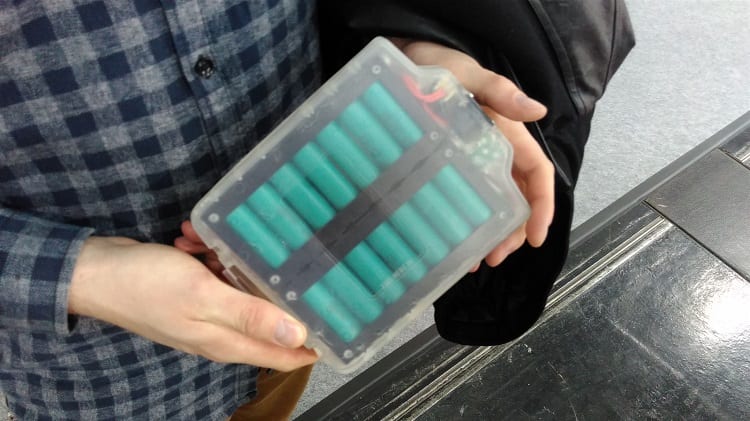
Any lithium-ion battery can overheat.
Yes, it’s possible, but it’s not likely. Based on the placement of your lithium-ion battery pack, you’ll have proper ventilation.
If you notice, there’s not an extremely thick layer of housing for battery packs on electric skateboards.
This is because you need to have enough clearance that you aren’t scraping on the pavement, but also so that you can ensure the safety of your battery.
If you’ve ever looked up going the DIY route with your own electric skateboard, you’ve seen the flat and slender battery packs before.
They fit perfectly under your board while having enough space for wiring as well.
So can it overheat?
Yes.
Conditions for this would be leaving it upside-down in the sun so the battery pack housing would heat up over a short amount of time, or if the asphalt is extremely hot and you aren’t moving all that much.
On average, the asphalt beneath our feet is about 15°F hotter than the air during summertime months.
If you’re just standing still, that heat rises up and warms the battery housing.
Through actively riding your board, you’re pulling in a lot of cooling air underneath your board, which should prevent this from happening.
It’s like having a fan on a high-performance PC: you need that airflow to keep things cool and operable.
PSA: Check Your Electric Skateboard Batteries Often
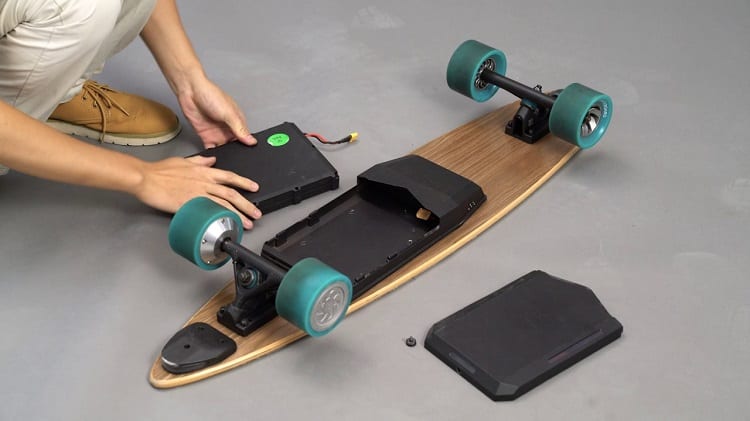
Electric skateboard batteries are lithium-ion, just about every single time.
That’s good, because these are reliable batteries, but they’re not bulletproof. Especially where they’re stored underneath your board, they run the risk of abrasions.
This is more common in phone batteries with how often we drop our phones, but you can damage the cells inside of the battery pack.
This leads to a reaction that causes gas expansion inside of the battery. You can spot this by removing the battery and holding it in front of you so you can get a side profile.
If it’s the same level of thickness from top to bottom, you’re good. If it slightly bows out in the center, that’s bad.
This can lead to battery leaks, fire, and potential explosions. On top of that, your battery retention times will suffer immensely.
A 40-minute charge will end up being more like 15 minutes, which is the first indicator of this problem.
Check your battery pack often to be sure everything is ship shape.
Electric Skateboards Legality
Are they even legal? Well, yes and no. It gets complicated, but I’m going to do my best to explain all of it.
Municipality Ruling
Most of the time, this is a very local issue. Your municipality might only have the jurisdiction of the city you live in, or a few neighboring towns.
Every single one of them is different. However, they control laws to some extent.
If you have a police office near you, the sign might read “Police Department & Municipality Office) or something to that effect.
They will have local guidelines and rules that must be followed, and with smaller things like electric vehicles (not cars), they tend to see what fits for the area and adjust rules accordingly.
You should have access to this information through localized websites. Check here first before you even consider buying an electric skateboard.
State Ruling
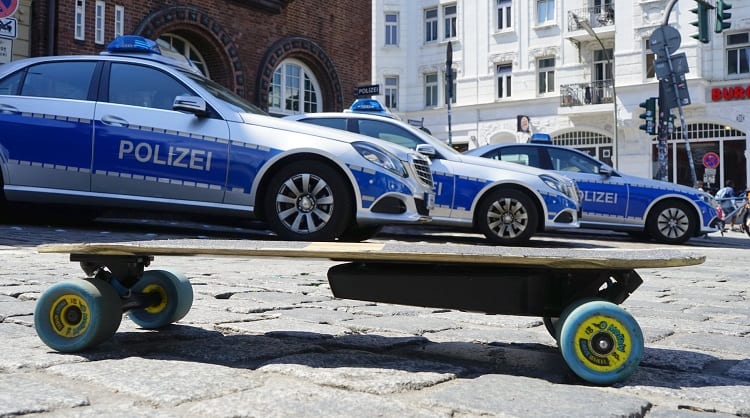
It’s rare for an entire state to outlaw something, but it does happen.
States like Florida have actually banned the use of electric skateboards on public property, from Pensacola all the way down to the tip of Miami—no electric skateboards.
Now, that doesn’t mean it’s illegal to own one, it just means that you can’t use it on public property.
You can use it in your driveway, your paved backyard, or any property that you own at all. No parks, parking lots, sidewalks, or roads.
If you take an off-road electric skateboard, you can use it on non-public properties, but no known hiking trails or anything of the sort.
Speed Limits
You have to abide by the law, and that means if a road has a 20 MPH speed limit, you’re part of that.
I know people who have been ticketed while riding on bicycles: rules of the road are for everyone, not just motorists.
It’s easy to forget that when we’re using a recreational, leisurely vehicle like an electric skateboard, and just whiz by everything we see.
You can get ticketed, and even taken to traffic court over violations regarding an electric skateboard.
For this reason, nobody should be using electric skateboards on sidewalks or any pedestrian walking areas.
At a certain speed, it’s just for recreation. When it can average 20 MPH or more, it’s a street vehicle, and you should be riding in the bike lane.
Riding Areas
While you can’t go into a publically-owned area, you can go into private ones.
That doesn’t specifically mean it has to be your private area. If you have the option, ask a local business owner with a large parking lot or concrete area if you can use your electric skateboard outside.
This is probably not a big deal for adults who just want a place to shred, but if children ask, they’ll most likely be declined.
It might be important to say you’ll sign a waiver and show proof of personal insurance, but that’s a stretch for a business owner to let you do something for free that they don’t benefit from at all.
Operation
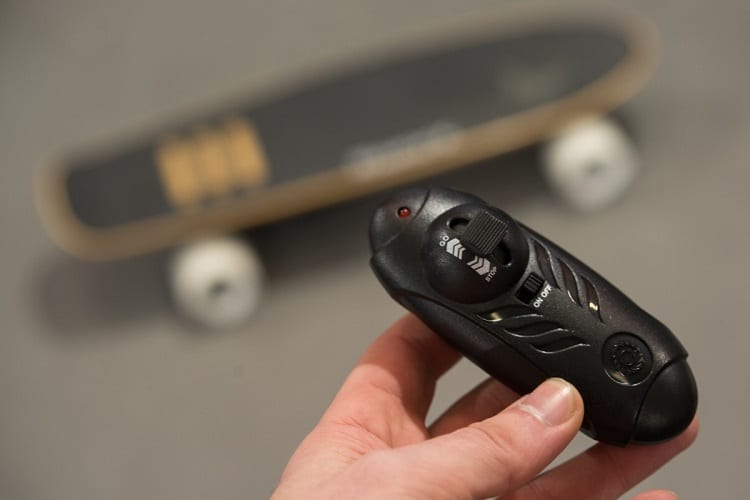
If you turn the switch on, it’s operating the skateboard. That means even if you don’t actually ride on it, you’re still breaking the law by operating it in a public area.
I highly doubt any police officer is going to catch you on this unless you’re being a public nuisance or difficult to deal with, mind you, but just keep it off to be safe and keep yourself protected.
If you’re able to use this in the city to get around and commute, that’s great, just be sure it’s off when you enter a subway or get on a bus.
Electric Skateboards are Future-Proof Transportation
The future is coming fast, and the population isn’t exactly going down.
Alternative transportation is future-proof: it relies on electricity, which we will always need for energy, and can be harvested from wind turbines or solar energy from your own home.
You’ve seen the best electric skateboards, you know what it takes to commute, and how to do it green—the ball is in your court now.
Which one of these skateboards spoke to you the most?

